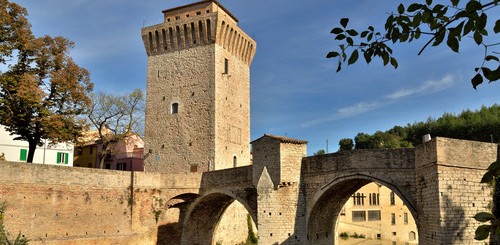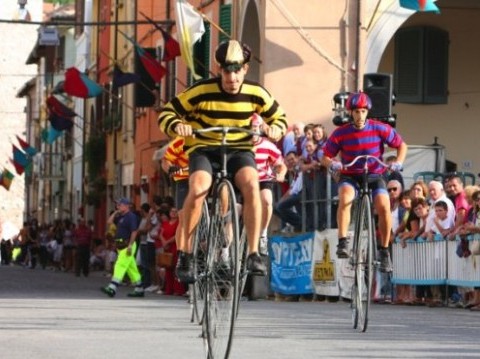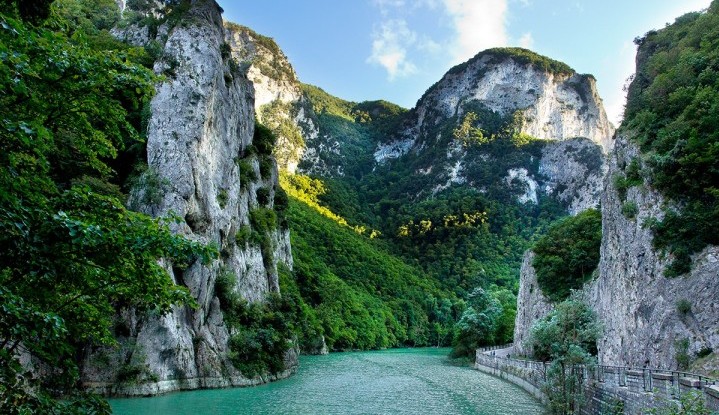Fermignano is located in the province of Pesaro-Urbino, in Le Marche region at few kilometres from Urbino. It is part ofthe Natural Reserve of the Gola del Furlo (Gorge) and is surrounded by a varied landscape. Besides being known as the birthplace of the great Renaissance artist Donato Bramante, Fermignano is famous for its lively and crowded festivals.
The town centre of Fermignano
Fermignano has a small but significant historical centre with old streets and monuments of great interest. The town symbols are "Il Ponte Romano" (The Roman Bridge), a three-arched structure that crosses a picturesque waterfall and the "Torre Medioevale" (Medieval Tower), a five-level building with four overlapping floors connected by a staircase, plus a basement formerly used as a prison cell. The Bridge and Tower constitute a single strategic complex; originally it served as a point to monitor and defend the town. In the bridge there is an old niche built in the second half of 1400, on Federico da Montefeltro's request, under the direction of Francesco di Giorgio. Inside you can admire a Madonna and Child from the late fifteenth century. The main street of the historic centre is Corso Bramante, which connects the Tower to Piazza Garibaldi, today the main square of the city. Here you find Palazzo Calistri which preserves some frescoes decorating the Private Chapel. At the end of the main street, at the foot of the Tower there's the public fountain called "Mascherone" built in 1886. Another square of the city is Piazza Santa Veneranda with its church decorated with an ashlar portal. It was built in the sixteenth century and rebuilt in Baroque style after the earthquake of 1781. Its interior retains the Rondelli painting dedicated to St. Francis of Paola; entrance is free. Finally there are the Churches of St. Maria Maddalena, built in the eighteenth century, the Church of St. Giacomo in Compostela located just outside the walls, with frescoes of the fourteenth and fifteenth century, the Church of Cristo Lavoratore and the Church of Maria Santissima. There is no lack of historic buildings either, starting from the former slaughterhouse, the washhouses, currently visitable by appointment and the former paper mill. Located at about one kilometre from the town there's Villa Gentilizia, a country residence of Federico Bonaventura. In 1578 the property was home to Torquato Tasso, who composed "O del grand'Appennino" universally known as "Canzone al Metauro". You can visit the structure every first Monday of each month from 9 am to 12 pm by appointment. Finally, the Contemporary Art Gallery, a building used as a Exhibition Hall and Town library divided into several rooms with large terraces, where during the summer evenings lectures, film screenings and many other events are organised. Inside there are also areas for children.

Events
Fermignano plays host to several events every year, most notably the Palio of the frog, a historical tournament that takes place on the first Sunday after Easter. Frogs are the undisputed stars of the festival and have to face a run of about 170 metres. The race is preceded by a parade with local people wearing beautiful costumes. The days prior the race are full of other side events, such as markets, street performers, fireworks and tastings of typical products. Another date to put in your diary is the Beer Festival, in mid-July. A whole week dedicated to music and craft beer tastings. Fun is guaranteed! In late summer, in particular on the first Sunday of September takes place the Grand Prix of 19th century Penny Farthing, known throughout Italy and abroad. It is a race between 7 districts that compete along the town centre streets riding beautiful bicycles and wearing past costumes. Once again, for several days the town welcomes performances, exhibitions, fashion shows, markets and much more.

Industry
Fermignano has always had a great industrial vocation, as witnessed by the Paper Mill, the wool mill Lanificio Carotti, the pasta factory Falasconi, the tobacco factory Donati and some furniture factories. These are just some of the historical businesses that gave life to this town. Today there is a large industrial area, an important element on which the town's economy is based.
Typical products
The inland of Le Marche is renowned for its fine cuisine and drinks: wines, cheeses, cold cuts, homemade pasta and desserts are just some of the products of this area. The flagship dishes of local cuisine are surely meat specialities: cut fillets, grilled meats and roasts accompanied by fine wines such as Verdicchio, Rosso Conero and Rosso Piceno. In addition, handmade pasta is a must to choose as main course in this area. It is served with classic meat sauce, black or white truffle or mushroom sauce.
Gola del Furlo
It is an ancient gorge shaped by the river Candigliano. In ancient times the Romans made the road from Rome to Rimini pass from here and it is still possible to follow it on foot or by bike using the pedestrian and bike path. Various trips are possible, such as the walking up to the Testa del Duce (The Head of the Duce), the rocky profile of Mussolini and there is also an adventure park with lots of activities for adults and children. Since 2001, the Gola del Furlo has been a National Park and is home to many animal species: the golden eagle, the peregrine falcon, the woodpecker, the wolf etc. In the vicinity of the gorge you can visit the Benedictine Abbey of San Vincenzo and the Sanctuary of the Madonna del Pelingo. I suggest you to make a stop at the kiosk next to the Abbey, where they serve home-made piadina, a kind of flat bread with any sort of filling...absolutely amazing! There are also several natural areas where you can relax and let your children play.
To find out more, you can check here: http://www.riservagoladelfurlo.it/











